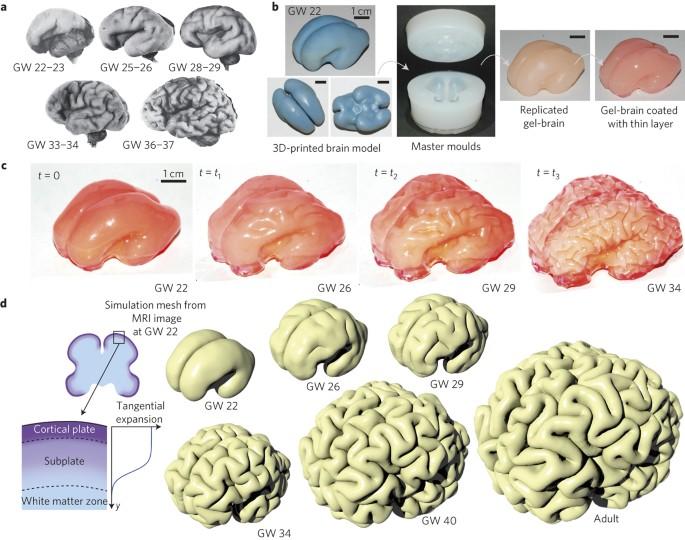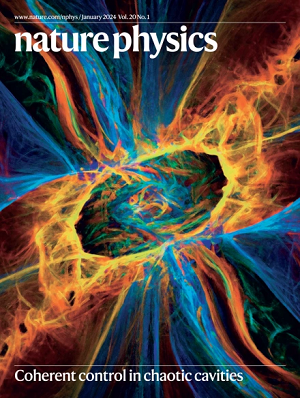关于皮质卷曲的生长和形态
IF 18.4
1区 物理与天体物理
Q1 PHYSICS, MULTIDISCIPLINARY
引用次数: 405
摘要
三维打印的胎儿大脑经过受限膨胀,再现了人类大脑皮层的形状。模型的软凝胶在溶剂中膨胀,模拟了大脑皮层的生长,并揭示了大脑折叠几何形状的机械起源。人类大脑皮层在发育过程中迅速生长,同时大脑也折叠成高度卷曲的结构1,2,3。最近的研究主要集中在大脑皮层生长的基因和细胞调控4,5,6,7,8,但要了解回旋和沟状褶皱的形成,还需要考虑生长中大脑的几何形状和物理塑形9,10,11,12,13,14,15。为了研究这一点,我们利用磁共振图像构建了一个三维打印的分层凝胶模拟发育中的光滑胎儿大脑;当浸入溶剂中时,外层相对于核心膨胀,模拟大脑皮层的生长。这种相对生长使外层受到机械挤压,形成与胎儿大脑相似的脑沟和脑回。从相同的初始几何图形开始,我们还对大脑进行了数值模拟,将其模拟为具有生长皮层的软组织,结果表明,这也能在现实的发育过程中产生特征性的漩涡模式。总之,我们的研究结果表明,虽然许多分子决定因素控制着大脑皮层的切向扩展,但褶皱的大小、形状、位置和方向是通过胎儿早期大脑几何形状调节的基本机械不稳定性的迭代和变化而产生的。本文章由计算机程序翻译,如有差异,请以英文原文为准。

On the growth and form of cortical convolutions
A 3D-printed fetal brain undergoes constrained expansion to reproduce the shape of the human cerebral cortex. The soft gels of the model swell in solvent, mimicking cortical growth and revealing the mechanical origin of the brain’s folded geometry. The rapid growth of the human cortex during development is accompanied by the folding of the brain into a highly convoluted structure1,2,3. Recent studies have focused on the genetic and cellular regulation of cortical growth4,5,6,7,8, but understanding the formation of the gyral and sulcal convolutions also requires consideration of the geometry and physical shaping of the growing brain9,10,11,12,13,14,15. To study this, we use magnetic resonance images to build a 3D-printed layered gel mimic of the developing smooth fetal brain; when immersed in a solvent, the outer layer swells relative to the core, mimicking cortical growth. This relative growth puts the outer layer into mechanical compression and leads to sulci and gyri similar to those in fetal brains. Starting with the same initial geometry, we also build numerical simulations of the brain modelled as a soft tissue with a growing cortex, and show that this also produces the characteristic patterns of convolutions over a realistic developmental course. All together, our results show that although many molecular determinants control the tangential expansion of the cortex, the size, shape, placement and orientation of the folds arise through iterations and variations of an elementary mechanical instability modulated by early fetal brain geometry.
求助全文
通过发布文献求助,成功后即可免费获取论文全文。
去求助
来源期刊

Nature Physics
物理-物理:综合
CiteScore
30.40
自引率
2.00%
发文量
349
审稿时长
4-8 weeks
期刊介绍:
Nature Physics is dedicated to publishing top-tier original research in physics with a fair and rigorous review process. It provides high visibility and access to a broad readership, maintaining high standards in copy editing and production, ensuring rapid publication, and maintaining independence from academic societies and other vested interests.
The journal presents two main research paper formats: Letters and Articles. Alongside primary research, Nature Physics serves as a central source for valuable information within the physics community through Review Articles, News & Views, Research Highlights covering crucial developments across the physics literature, Commentaries, Book Reviews, and Correspondence.
 求助内容:
求助内容: 应助结果提醒方式:
应助结果提醒方式:


